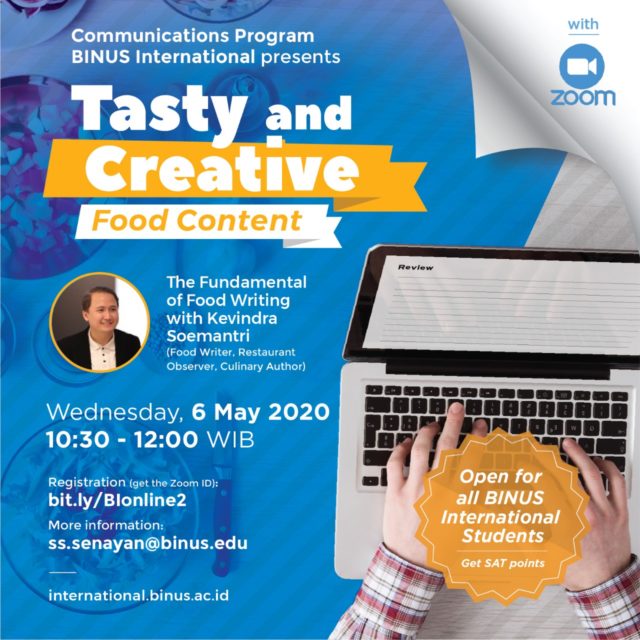Food Writing as a New Mastery in the Culinary Arts

The progress of the world of Journalism has often misjudged by the greater public, as they would think that it is all for hard news and everything would ended up within the loop of political affairs. However, the rise of awareness within the industry of food and culinary has developed on a rapid scale within these past few decades. However, due to the lack of understanding, it all slips under the public’s awareness. As it was researched, the history of food writing was started as early as 2000 years BC by the Egyptians and has undergone many changes up until today. The changes, which people don’t really understand, is the main dark spot that was intended to be enlightened by the session of Food Writing, fostered by BINUS International’s Communication Major and Kevindra Soematri -co founder of Top Tables, a Food Media based in Jakarta- as the guest speaker.
“Nowadays, Food is not just about being a chef and able to cook. It is much greater than that”, Kevin implied. Through his extensive past experience as a column writer for Jakarta Post and as the narrator of Netflix’s Street Food – Indonesia series, he explained to the audiences in regards of two things: sharing the basic information of food writing and also encouraging people to do it so that the people doesn’t get a fear of overwhelmed by the terms. The reason is that Food Writing has developed into multiple types. Kevin mentioned that through his perspective, it could be differentiated into:
- Recipes. Yes, it is also included within a type of Food Writing. The process of poring over the ingredients and explaining the process into a certain media is indeed a proof to it. The types are varying from practical cooking recipe, culture based recipe and recipe + stories (history and memoir)
- Literature. With the writing style of storytelling in a vivid manner, most of the food writing here are displayed in the form of a literature book, such as novels that is both contain historical values and fictional. The notable example is the nation – wide acclaimed Aruna & Lidahnya which has been adapted into widescreen movie in 2018.
- Academic. With the purpose or obtaining data, the writing style of this section is heavily towards research – based and analytical. A keen and simple example is through a research towards the target market of a certain area in hope of finding the preferable taste.
- Reviews and Guides. In the United States, they have Yelp. In Indonesia, there are numerous such as Zomato. But the idea of this aspect is what generates the career of becoming a Food Blogger within Instagram platform and Food Reviewers in YouTube.
He further explained that the relevancy towards the cultural impact is what sets the Food Writing’s standard of relevancy to be very high. This has something to do with the creation of a certain trends, such as Boba Drinks that was originated from the culture of the Taiwanese culinary, etc.
Food Writing, in the eyes of Kevindra, has created such an extensive open platform for people to share information and provide constructive criticism. Furthermore, the voices of these writings could also help to put a new spotlight towards the newer generations of cuisine and restaurants that embrace styles that hasn’t been existed a few moments before. It therefore, bridges the world of culinary towards the cycle of life that will constantly evolving over times.
Contributor: Krisna Ananta Ong / Communications Binusian 2021
Editor: Dian Ayuria Sarwono


